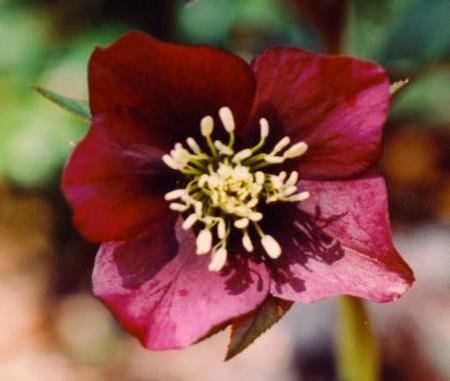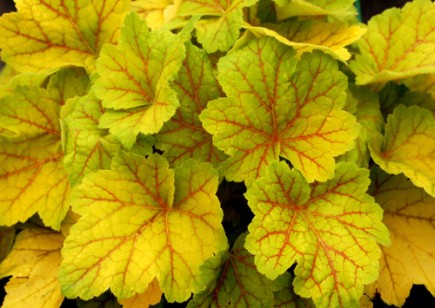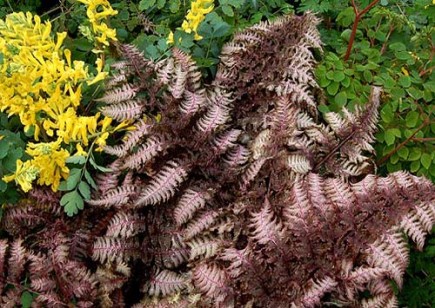Carolyn’s Shade Gardens is a retail nursery located in Bryn Mawr, PA, specializing in showy, colorful, and unusual plants for shade. The only plants that we ship are snowdrops and miniature hostas. For catalogues and announcements of events, please send your full name, location, and phone number (for back up use only) to carolyn@carolynsshadegardens.com. Click here to get to the home page of our website for catalogues and information about our nursery and to subscribe to our blog.
Plant breeders have been hard at work for years trying to get hybrid hellebores (Helleborus x hybridus) to submit to tissue culture. For a long time the hellebores were winning, and I was quietly cheering from the sidelines. But it seems even the mighty hybrid hellebore, the toughest plant I know, was not a match for modern technology. You can now purchase tissue cultured hellebores that all look the same. But my question is: why would you want to?
You have to realize that I am a person who treasures diversity even with its inherent risks of dissatisfaction and unpredictability. I still shop at my local hardware store with its wood floors and oily smells. I have a tab, the people there know me, the people there know hardware. They might not have what I want—I can take that risk. You couldn’t get me to go to a Home Depot if my life depended on it.
When I travel, I try to stay at a local B&B. I introduce myself to the owners, I appreciate their eclectic decorating schemes, I eat their funky breakfasts. They know the local area, they have eaten in the restaurants, they can give directions. I stayed at a chain recently where the very nice desk clerk was not aware that there was a gas station two doors down.
So I am a person who doesn’t treasure predictability, as in sameness, the way most people seem to.
When it comes to hybrid hellebores, I don’t understand the most common concern expressed by gardeners: if the hellbore is grown from seed you can’t be 100% sure what the flowers will look like unless it’s in bloom. There is an element of risk involved in the purchase. Tissue culture of hellebores was developed to eliminate this unacceptable risk.
But to me that is the magic of hybrid hellebores: each plant is a unique individual, with the potential for inheriting genetic material from any of the possible 9 or more species that could be its parents. It’s like having a baby, you don’t know and you can’t control who he or she will be because that is determined by generations of intertwining DNA. I am assuming that even in the predictability driven US, where we invented the almighty chain store, we still would rather roll the dice than clone the cute little baby next door. I could be mistaken.
Don’t get me wrong, the poster child for tissue-cultured hybrid hellebores ‘Kingston Cardinal’ with its large double raspberry flowers is gorgeous. I would grow it. But here is its main marketing mantra: Tissue cultured so every plant is identical. Every one on your block can have the exact same plant right next to their ‘Autumn Joy’ sedum and ‘Goldsturm’ rudbeckia. I like ‘Autumn Joy’ and ‘Goldsturm’ (I have them in my garden), but hybrid hellebores offer so much more than that: the diversity of life in a beautiful flower. And tissue culture has the potential to destroy that magic just like we are losing the genetic magnificence of apples, and chickens, and tomatoes.
Here is my ode to seed strain hybrid hellebores:
Please let me know in a comment which hellebore is your favorite.
Carolyn
This is part of a series of articles on hellebores, one of the specialties of my nursery. Here are links to the other articles:
Part One Hellebores for Fall
Part Two An Ode to Seed Strain Hellebores
Part Three Christmas Rose: The Perfect Hellebore
Part Four Dividing Hybrid Hellebores
Part Five The Sex Lives of Hellebores
Part Six Double Hellebores
Part Seven Cutting Back Hellebores
Notes: Every word that appears in orange on my blog is a link that you can click for more information. If you want to return to my blog’s homepage to access the sidebar information (catalogues, previous articles, etc.), just click here.
In my post I Need Your Help, I asked readers to send cards to the daughter of Kartik who was the subject of my post New Year’s Resolution to Edit the Garden. I would still appreciate your help with this appeal. Tara is home from the hospital, which is good news, but being confined to home and suffering daily intrusive medical procedures has left her lonely and depressed. The cards she has received from all of you are a major bright spot in her day, and your good wishes and prayers are an inspiration to Kartik. If you still wish to mail a card, they would love to receive it (Tara Patel, 2216 Oakwyn Road, Lafayette Hill, PA 19444, USA). Thanks.
The view from here:



















































































